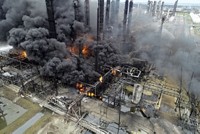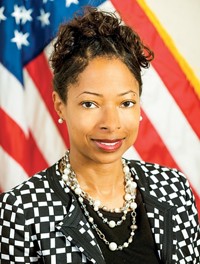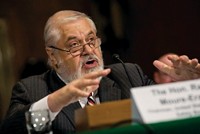Advertisement
Grab your lab coat. Let's get started
Welcome!
Welcome!
Create an account below to get 6 C&EN articles per month, receive newsletters and more - all free.
It seems this is your first time logging in online. Please enter the following information to continue.
As an ACS member you automatically get access to this site. All we need is few more details to create your reading experience.
Not you? Sign in with a different account.
Not you? Sign in with a different account.
ERROR 1
ERROR 1
ERROR 2
ERROR 2
ERROR 2
ERROR 2
ERROR 2
Password and Confirm password must match.
If you have an ACS member number, please enter it here so we can link this account to your membership. (optional)
ERROR 2
ACS values your privacy. By submitting your information, you are gaining access to C&EN and subscribing to our weekly newsletter. We use the information you provide to make your reading experience better, and we will never sell your data to third party members.
Industrial Safety
Changes on tap at U.S. Chemical Safety Board
Chair departs, investigators leave, staff fears changing mission
by Jeff Johnson
June 25, 2018

Following a briefing in late June, Vanessa Allen Sutherland formally ended her three-year stint as chair of the U.S. Chemical Safety & Hazard Investigation Board (CSB). She described her term on the board as a “fix-it” role for the small independent government agency, which investigates chemically related industrial accidents.
She refused to say where she was headed professionally or exactly why she cut short her five-year board term. She stressed a need for more time for her family, particularly her elementary-school-age daughter. However, rail transportation company Norfolk Southern announced on June 25 that Sutherland was joining the company as vice president law, effective that day.
Sutherland took over board leadership in 2015 following a period when CSB was under attack by members of Congress and federal oversight agencies, particularly the Environmental Protection Agency’s Office of Inspector General. U.S. President Barack Obama had called for the resignation of the board’s then-leader, who Sutherland replaced.
CSB stakeholders hoped that Sutherland’s arrival would calm the turbulence and let the agency refocus on what it does best—investigations that go beyond identifying degraded pipes or broken valves to reveal the deeper causes of incidents, such as a plant culture of ignoring safety alerts. As she departs, however, trouble may again be brewing.
Prior to Sutherland becoming chair, complaints reported to Congress by unnamed CSB staff alleged mismanagement and internal disruption. Criticism also centered on delayed accident investigation reports. When Sutherland arrived in 2015, six reports were incomplete, one of which stretched back six years.
In her first year, Sutherland emphasized clearing out these reports and declined to begin new investigations. CSB began new investigations again in 2016.
Now, as Sutherland departs, nine accident reports are in process, three more than when she arrived. One of these occurred in 2014, before she took over the board. That accident at a DuPont site involved a chemical process mix-up in which methyl mercaptan was accidentally released, killing four workers. The incident led the Occupational Safety & Health Administration (OSHA) in 2015 to label DuPont a severe violator of workplace safety regulations, a consequence that increased enforcement scrutiny and fines. However, CSB has yet to finalize its interim accident report.
Sutherland claims that the nine outstanding reports are nearly complete—further along, she said, than were the six when she arrived. She added that an agency such as CSB will always have accident investigations in process.
Sutherland also embarked on a program more broadly to streamline investigations and issue more timely reports. Those changes are in flux and details will be announced in July, according to Kristen Kulinowski, the board member taking over as interim executive authority following Sutherland’s departure.
“I am comfortable in being able to step down at this time,” Sutherland said at the June briefing. CSB is in a place where new leadership can easily take the next step to make the board more efficient, innovative, and successful, she said. Sutherland underscored her success in rebuilding CSB infrastructure, reforming management, and hiring skilled staff.
Both Kulinowski and Sutherland underscored the difficulty of running a small federal agency with merely 32 staff and an $11 million budget. Hiring and retaining staff, long-term budgeting, and strategic planning have been extremely difficult for the board, which has never had sufficient funds to meet its investigative requirements under law. Some federal reports have found the universe of accidents that qualify for CSB investigation can reach 150 or more a year, far beyond the half-dozen CSB has resources to investigate.
Advertisement
Those preexisting challenges have been exacerbated under President Donald J. Trump, who has proposed eliminating CSB in the past two federal budget cycles. In both cases, Congress stepped in to fund the agency and keep it alive, but the uncertainty has made things such as staff recruitment more difficult for the agency, Sutherland and Kulinowski said. Additionally, the White House must nominate a new chair and other board members, and Trump is unlikely to do so. Of the three remaining board members, Manuel (Manny) Ehrlich and Rick Engler’s terms end in December 2019 and Kulinowski’s term ends in August 2020, just months before the next presidential election. By statute, CSB should have five board members.
The board also appears to be facing a revolt among some staff over hiring and fears CSB is changing its mission. In interviews and in an anonymous memo, prepared by “six senior CSB investigators,” a litany of complaints has been lodged against board management. The critics warn of loss of quality of accident investigations and reports, degrading working conditions, mismanagement, and waste.
In the anonymous memo, the senior investigators note that since Sutherland arrived three years ago, the number of accident investigators has declined through attrition and resignations from 20 to 12 with no new hires. Meanwhile, they continue, CSB hired five management specialists and human relations experts. The investigators also see a general trend toward briefer investigations and reports. They cite a growing focus by management on the immediate and direct cause of an accident, such as a broken pipe or gauge, rather than a detailed root cause review that uncovers the overall conditions that led to an accident.
Such deeper investigations and reports have been CSB’s bread and butter. Many CSB investigations and reviews have revealed industrywide poor practices, long-ignored company conditions, and regulatory shortcomings that led to an accident. Frequently, CSB investigators found that the conditions that triggered deadly accidents had been discovered but not addressed by companies years before an accident occurred. Investigators have also identified significant gaps in industry regulations. Companies or regulators are unlikely to point fingers at themselves, but uncovering such information lays the groundwork for safety improvements, according to several former and current CSB investigators.
In the memo and interviews, investigators say they believe expert peer and stakeholder review of draft reports will be curbed or eliminated. Having drafts reviewed by companies, unions, and other stakeholders familiar with the facility is essential for report accuracy, investigators say. They are also concerned that a possible shift to contracting report writing to outside professionals will reduce accuracy.
The staff also say tension between staff and management has been exacerbated by top managers recently brought in from other federal agencies. Those managers have devalued their work and have little experience in industrial accident investigations, staff say.
Kulinowski and Sutherland countered those allegations at the briefing, saying that hiring and replacing lost staff is their top priority. A “human capital report” to be released next month will show new job descriptions and a blueprint to bring the agency back to full staffing, Kulinowski said.
She added that she was unaware of staff complaints regarding top management. “I always have an open door,” she said, “and will listen to any staff complaint and take it from there.”
Kulinowski and Sutherland also stressed that the focus on root-cause investigations will continue but with a greater emphasis on timeliness and transparency. Kulinowski noted that for reports to be relevant, timeliness must be improved and that demand has often come from staff as well as companies, Congress, labor unions, and others.
CSB is the only body worldwide dedicated solely to investigate large chemically related industrial accidents and publishing their causes. Other organizations examine industrial accidents, but they are regulators or companies searching for causes. Regulators issue fines based on findings; companies may correct problems but do not reveal causes. Neither is likely to reveal their own flaws.
CSB, in contrast, issues no fines or regulations and is independent from regulators and companies. This independence has been a source of strength for the agency but also a source of problems that stretch back to its birth as part of the Clean Air Act, which former president George H. W. Bush signed into law in 1990. Neither Bush nor Bill Clinton funded CSB until 1998, following a series of New Jersey industrial accidents. The accidents were investigated by EPA and OSHA, but their reviews were slow and inadequate, said community and union members and some in Congress, leading Clinton to provide $3 million for CSB’s first year.
Since then, CSB’s history has seesawed between criticism and threats of elimination—with support frequently coming only following an accident with severe consequences for a plant, its workers, and the surrounding community.
Jeff Johnson is a freelance writer based in Washington, D.C.
Update: This story was revised on June 26, 2018, to add information about Vanessa Sutherland joining Norfolk Southern.





Join the conversation
Contact the reporter
Submit a Letter to the Editor for publication
Engage with us on Twitter